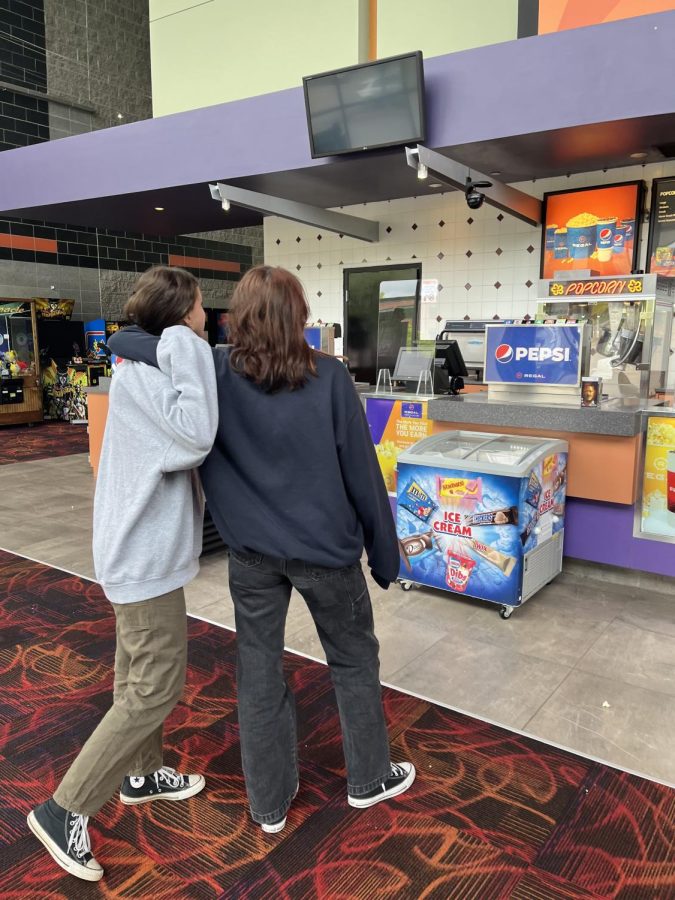There’s more to horror movies than meets the eye
What drives people’s obsessions with these dark, unsettling stories?
Two teens pick out their snacks in a nearly empty theater. Despite the drop in movie theaters’ popularity in the past two years, many people have begun to return to the box office for their movie needs.
The movie theater looked old and creaky, as if it belonged in the horror movie we were going to see. The pandemic took its toll on everything, and our town cinema was no exception. A sign on the popcorn machine read, “Out of Order,” and a lone, harried cashier stood behind the counter. Because of a lack of workers, there was no usher to take our ticket. We didn’t care about the lack of amenities–we were there to be scared.
But why are moviegoers, particularly teens, drawn to the horror genre? There are multiple theories. It is a bonding experience, an adrenaline rush — a way for teens to feel like we’ve survived something together.
Darkened theaters become an outlet for experiencing these themes in a protected environment. We know that after the movie ends we will still be okay.
Hollywood studios churn out these films at a rapid pace, and many are terrible. The best ones are able to scare us while also exploring deeper issues. If a movie leaves you contemplating its significance, it succeeded.
There is no better example of this than when after the theater lights dimmed and we watched a trailer for one of this summer’s most anticipated movies: Jordan Peele’s Nope. The trailer leaves more questions than answers about the plot, but we were enthralled.
Peele is already one of the most skilled horror directors working today. His films Get Out and Us are not only social metaphors for the racism dividing our country, they left me with a sense of dread.
He presents these current issues through dark lighting and an eerie quietness that causes us to reflect on the deeper implications of the story.
According to The Washington Post, the success of these films can be credited to “[Peele’s] knack for scaring us, and making us think at the same time.”
Peele comes from a line of filmmakers who have used horror to explore large social issues. In the 80s, John Carpenter directed They Live, an alien invasion firm which examined class-warfare and consumerism.
The theater went dark and the main attraction was on the screen– We’re All Going to the World’s Fair, directed by upcoming director Jane Schoenbrun.
Almost the entire movie takes place on the property of the protagonist, Casey. It’s a distributing, psychological horror film that explores the role of technology among younger generations, and how it shapes their identity.
The director kept us off-balance, taking us back and forth between the horrors and confusion of the internet, to a place of comfort, a place where we can find others who share similar interests during a time in our lives where we feel the most isolated.
This movie, like all successful ones in this genre, made us cringe and shriek. We covered our eyes before it captured us in fearful curiosity.
At the same time it made us question the deeper issue (told through a combination of neon paint and stuffed animals) of our changing relationship with technology.
In 2022 this is very prevalent. We have growing anxieties about the effects of technology and continue to question its future. This movie reinforces the idea that this bond between technology and reality was inevitable from the start.
Leaving the movie we felt relieved. We had experienced a horror in someone else’s world, and had survived. We have a few moments of quiet reflection before we hit the theater doors.
It’s possible these films, which effectively shine a light on important issues, can change the way people live, and in turn change the outcome of the future. A thought-provoking film would leave people with a new perspective, and in doing this, would bring a higher purpose to the role of a filmmaker.
We exited the theater, rehashing the movie we had just seen. But now in the harsh light of day, it is clear our experience, however nerve-wracking, was only a temporary respite from what we find on the outside: wars, climate change, pandemics, inflation, a mental health crisis, and of course, technology.
It looks like summer 2022 will be a good season for movies. But no matter how creative directors like Jordan Peele and Jane Schoenbrun may be, the world outside the theater doors is much, much scarier.











